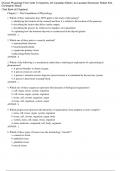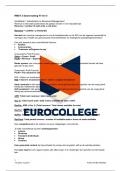(Human Physiology From Cells To Systems, 4th Canadian Edition, 4e Lauralee Sherwood, Robert Kell,
Christopher Ward)
(Test Bank all Chapters)
Chapter 1 - The Foundation of Physiology
1. Which of these statements does NOT apply to the study of physiology?
a. identifying the location of the stomach and how it is related to the location of the pancreas
b. describing the factors that affect cardiac output
c. describing the process by which nerve impulses are transmitted
d. explaining how the hormone thyroxin is synthesized in the thyroid glands
ANSWER: a
2. Which one of these pairs is correctly matched?
a. anatomy/body function
b. bacteria/multicellular
c. organs/one primary tissue
d. physiology/body function
ANSWER: d
3. Which of the following is a mechanistic rather than a teleological explanation of a physiological
phenomenon?
a. A person breathes to obtain oxygen.
b. A person sweats to cool off.
c. A person’s stomach secretes digestive juices because it is stimulated by the nervous system.
d. A person’s heart beats to pump blood.
ANSWER: c
4. Which one of these sequences represents the hierarchy of biological organization?
a. cell, organ, tissue, system, organism
b. cell, tissue, organ, system, organism
c. tissue, cell, system, organism, organ
d. tissue, cell, organism, system, organ
ANSWER: b
5. Which progression represents the hierarchy of organization, from simplest to more complex?
a. atom, cell, tissue, organ, system, organism
b. tissue, cell, system, organism, organ, body
c. system, atom, cell, organ, tissue, organism
d. atom, molecule, compound, cell, body, organism
ANSWER: a
6. Which of these types of tissues uses the terminology “smooth”?
a. connective tissue
b. epithelial tissue
c. glandular tissue
d. muscle tissue
Copyright Cengage Learning. Powered by Cognero. Page 1
,Name: Class: Date:
Chapter 1 - The Foundation of Physiology
ANSWER: d
7. Which of these tissues can be found on the outer layer of the skin?
a. connective
b. endocrine
c. epithelial
d. muscle
ANSWER: c
8. What type of tissue consists of cells specialized for transmitting messages?
a. connective
b. muscle
c. bone
d. nervous
ANSWER: d
9. Epithelial tissue is organized into which of the two general types of structures?
a. cells and cell walls
b. epithelial sheets and secretory glands
c. ducts and nuclei
d. protective and absorptive
ANSWER: b
10. Which of these statements is characteristic of connective tissue?
a. It has relatively few cells dispersed within an abundance of extracellular matrix.
b. It has no blood vessels.
c. It covers various parts of the body.
d. It is usually found in the walls of hollow cavities.
ANSWER: a
11. Which of the following statements does NOT apply to connective tissue?
a. It includes bone.
b. It includes blood.
c. Elastin can be found in its extracellular material.
d. It forms coverings and linings of the body cavities.
ANSWER: d
12. Which of the following is a type of connective tissue?
a. exocrine glands
b. endocrine glands
c. blood
Copyright Cengage Learning. Powered by Cognero. Page 2
,Name: Class: Date:
Chapter 1 - The Foundation of Physiology
d. smooth muscle tissue
ANSWER: c
13. What kind of glands secrete through ducts to the outside of the body (or cavity open to the outside)?
a. endocrine
b. embryonic
c. external
d. exocrine
ANSWER: d
14. Which of the following are two examples of exocrine glands?
a. sweat glands and glands that secrete digestive juices
b. mammary glands and the pancreas
c. the bladder and the kidneys
d. thyroid gland and sweat glands
ANSWER: a
15. Which of these statements describes endocrine glands?
a. They consist of ducts.
b. They secrete hormones internally into the blood capillaries.
c. They are derived from connective tissue.
d. They include the salivary glands.
ANSWER: b
16. Which of these statements describes the internal environment?
a. It consists of intracellular fluid.
b. It is in direct contact with the body’s cells and consists of the extracellular fluid.
c. It is inside the body but not in direct contact with the body’s cells.
d. It is outside of the body and keeps the fluid volume in unchanging composition.
ANSWER: b
17. What type of fluid resides within cells?
a. intracellular
b. interstitial
c. extracellular
d. plasma
ANSWER: a
18. Which of these statements describes stem cells?
a. They are well-differentiated embryonic cells that may reproduce just one time.
b. They may reproduce just one time and cannot be readily grown.
Copyright Cengage Learning. Powered by Cognero. Page 3
, Name: Class: Date:
Chapter 1 - The Foundation of Physiology
c. Their daughter cells may differentiate into a number of different specialized cell types.
d. They cannot be readily grown unless they are already specialized cell types.
ANSWER: c
19. Which of these systems mainly distributes nutrients and oxygen through the body?
a. circulatory system
b. digestive system
c. endocrine system
d. integumentary system
ANSWER: a
20. Which of these statements describes extracellular fluid?
a. It is the external environment of the body.
b. It is the fluid inside each cell.
c. It consists of plasma only.
d. It consists of plasma and interstitial fluid.
ANSWER: d
21. Which of these statements applies to the respiratory system?
a. It eliminates unwanted substances from the body to the external environment.
b. It consists of the heart, blood vessels, and lungs in the pulmonary cavity.
c. It is important for maintaining the proper pH of the internal environment.
d. It is responsible for taking up required essential nutrients for the body.
ANSWER: c
22. In which of the body systems is calcium mainly stored?
a. endocrine system
b. integumentary system
c. muscular system
d. skeletal system
ANSWER: d
23. Which of these statements describes negative feedback?
a. A change in a regulated variable triggers a response by the effector that opposes the change.
b. The input to a system increases the output, and the output limits its own production by inhibiting the
input.
c. A control system’s input and output continue to enhance each other in order to maintain homeostasis.
d. It is the main operating principle of most of the body’s homeostatic control mechanisms.
ANSWER: b
24. What are the two systems concerned with the control of body functioning by extrinsic controls?
a. nervous and respiratory
Copyright Cengage Learning. Powered by Cognero. Page 4





